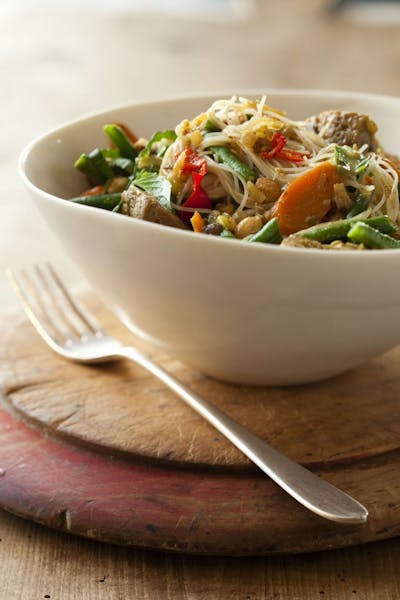What do Bill Clinton, Sandra Oh, Ellen DeGeneres, Alanis Morissette and Thich Nhat Hanh have in common?
They all are vegans, just like Robin Asbell.
She's the author of the new, hefty "Big Vegan" (Chronicle Books, 544 pages, $29.95), and she's thrilled to see the growing interest in this way of eating, which isn't new at all, despite its unfamiliarity to many of us.
Think of vegans as hyper-focused vegetarians, who avoid all forms of animal products -- including dairy, eggs and honey, in addition to meat. Vegans do so for a variety of reasons, be it spiritual or religious, or for health, environment or animal rights issues.
But this way of eating is not about deprivation, Asbell says without hesitation. It's about possibilities and what can be done within a wide range of dietary choices that includes vegetables, fruits, beans, grains, nuts and seeds.
Still, vegan diets have had an image problem for years, though even the American Dietetic Association gave them an official nod of approval in 2009 (parents shouldn't fear for the health of their vegan children, the ADA implied). Still, skeptics may raise their eyebrows, rather than their forks, at the prospect of a dinner plate without a hunk of meat or pat of butter on it.
Asbell was undaunted by the task of trying to convince meat eaters that they can go without. "I wanted to make the food as appealing and delicious as I could," said Asbell in an interview. "I wanted it to appeal to omnivores who really appreciate good food.
"I find that it's much better to seduce and tempt with good food than to tell people what to eat."
That meant maximum flavor on the plate. So Asbell turned to the world of flavors, as she looked to other cultures and flavor combinations.
"One of the great adventures of going vegetarian and vegan is to explore cultures where people have eaten this way or a long time, " she said.
Her secret flavor? Umami, the fifth type of taste, beyond sweet-sour-bitter-salty. It's the Japanese term for that indefinable meaty taste, which is technically tied to amino acids. It can be found in mushrooms, ripe vegetables, soy sauce and, of course, meat. To add it, Asbell often incorporates small amounts of miso, nutritional yeast and other umami-rich ingredients into her recipes.
She also turned to her restaurant training for inspiration. "I wanted to bring in reduction, caramelization, layering certain flavors. I used more sophisticated techniques, while also keeping it easy to prepare," she said.
Judging from the number of new cookbooks geared toward vegans, Asbell is right on the mark with this mini-trend.
"I've been anticipating this for a long time," she said. "I thought all this would happen a lot faster. The current boom is due to the environmental aspect. In recent years, people have been thinking about the environmental impact, the carbon footprint of food."
From Whole-Wheat Maple - Cherry Scones and Mediterranean Eggplant Relish With Pomegranate Molasses to Black Bean and Quinoa Burgers and Squash Quesadillas, Asbell offers more than 350 recipes, including how to make your own mock beef or seitan.
But as she reminds cooks, "It's not vegan food. It's just good food."
Asbell, who grew up in Illinois, has lived in Minneapolis for more than 20 years. She comes to cooking with an art degree and earlier plans to be a professor. She had already cooked her way through high school and college, and was in a master's program while working in a vegetarian restaurant when she changed her mind. Cooking would be her life's work. Today she teaches classes around the country, works as a personal chef and writes. She's the author of "The New Whole Grains Cookbook" and "The New Vegetarian." And she's got another book in the works, one on vegan whole-grain baking.
"I'm banking on this vegan thing going forward."
Lee Svitak Dean • 612-673-1749
